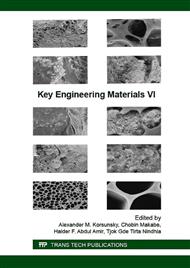[1]
M.J. Bermingham, S. Palanisamy, D. Kent, M.S. Dargusch, A comparison of cryogenic and high pressure emulsion cooling technologies on tool life and chip morphology in Ti–6Al–4V cutting, Journal of Materials Processing Technology, 212 (2012).
DOI: 10.1016/j.jmatprotec.2011.10.027
Google Scholar
[2]
Pravin Pawar, Sandip Patil, Kiran Gujar, Sachin Patil, Swapnil Kekade, RKP Singh, Effect of Cryogenic cooling media on machinability of Beta solution treated Titanium Alloy Ti6Al4V, International Journal of Mechanical And Production Engineering, 3 (2015).
DOI: 10.4028/www.scientific.net/kem.705.233
Google Scholar
[3]
O. Çakir, M. Kiyak, E. Altan, Comparison of gases applications to wet and dry cuttings in turning, Journal of Materials Processing Technology, 153-154 (2004) 35-41.
DOI: 10.1016/j.jmatprotec.2004.04.190
Google Scholar
[4]
Yue Zhang, Li Han, Taili Sun, Quan Liang, Xichuan Zhang, Study on Effect of Gases as Coolant and Lubricant on Machined Surface, Advanced Materials Research, 135 (2010) 424-428.
DOI: 10.4028/www.scientific.net/amr.135.424
Google Scholar
[5]
Yakup Yildiz, Muammer Nalbant, A review of cryogenic cooling in machining processes, International Journal of Machine Tools & Manufacture, 48 (2008) 947-964.
DOI: 10.1016/j.ijmachtools.2008.01.008
Google Scholar
[6]
Shoujin Sun, Milan Brandt, Suresh Palanisamy, Matthew S. Dargusch, Effect of cryogenic compressed air on the evolution of cutting force and tool wear during machining of Ti–6Al–4V alloy, Journal of Materials Processing Technology, 221 (2015).
DOI: 10.1016/j.jmatprotec.2015.02.017
Google Scholar
[7]
A. Bordin, S. Bruschi, A. Ghiotti, P.F. Bariani, Analysis of tool wear in cryogenic machining of additive manufactured Ti6Al4V alloy, Journal of Wear, 328-329 (2015) 89-99.
DOI: 10.1016/j.wear.2015.01.030
Google Scholar
[8]
A.E.I. Elshwain, Norizah Redzuan, Noordin Mohd Yusof, Machinability of Nickel and Titanium alloys under of gas-based coolant-lubricants (cls) – A Review, International Journal of Research in Engineering and Technology, 02 (2013).
DOI: 10.15623/ijret.2013.0211106
Google Scholar
[9]
A. Davoudinejad, E. Chiappini, S. Tirelli, M. Annoni, M. Strano, Finite Element Simulation and Validation of Chip Formation and Cutting Forces in Dry and Cryogenic Cutting of Ti–6Al–4V, Procedia Manufacturing (2015) 1-12.
DOI: 10.1016/j.promfg.2015.09.037
Google Scholar
[10]
Y. Sun, B. Huang, D.A. Puleo, I.S. Jawahir, Enhanced Machinability of Ti-5553 Alloy from Cryogenic Machining: Comparison with MQL and Flood-cooled Machining and Modeling, Procedia CIRP, 31 (2015) 477-482.
DOI: 10.1016/j.procir.2015.03.099
Google Scholar
[11]
Sandip Patil, Shashikant Joshi, Asim Tewari, Suhas Joshi, Modelling and Simulation of Ultrasonic Assisted Machining of Titanium alloy Ti6Al4V, International Journal of Ultrasonic, 54 (2014) 694-705.
DOI: 10.1016/j.ultras.2013.09.010
Google Scholar


